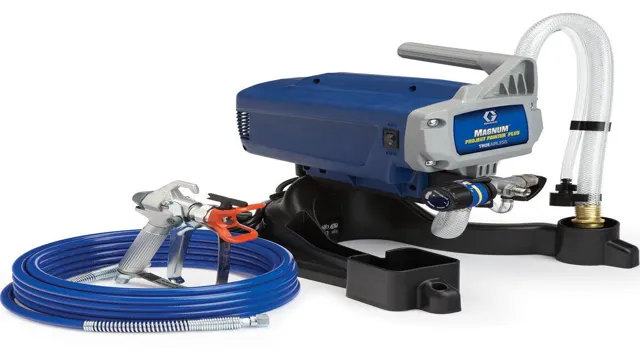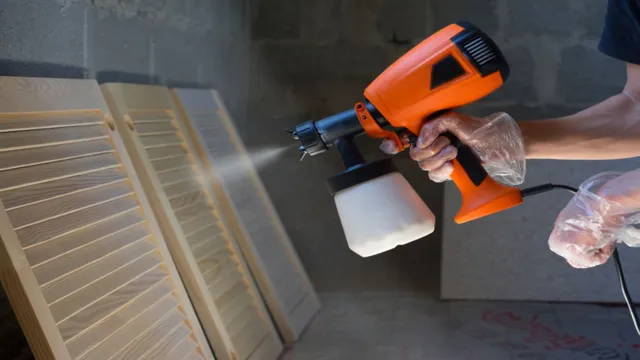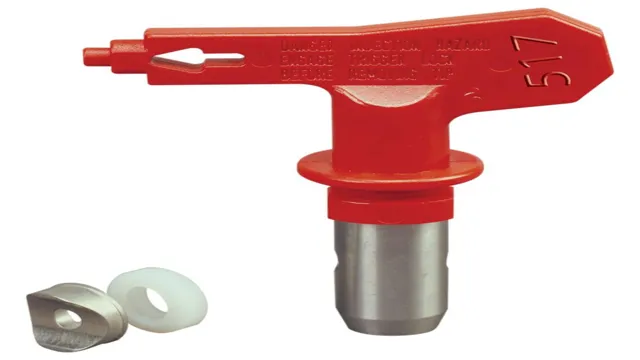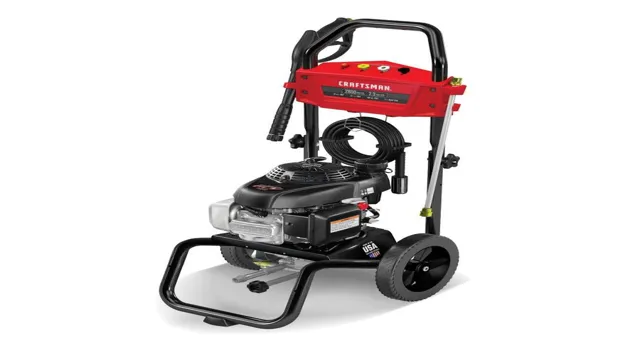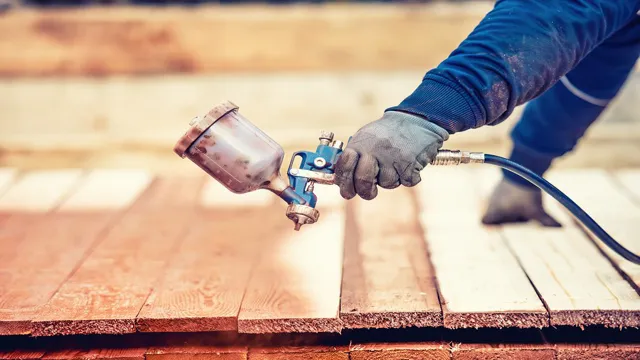How Do You Use a Paint Sprayer? A Beginner’s Guide to Spraying Paint Like a Pro

Are you tired of spending endless hours painting your walls or furniture by hand? Or maybe you’re looking for a more efficient way to complete your DIY projects? Look no further than using a paint sprayer! In this beginner’s guide, we’ll cover everything you need to know about using a paint sprayer, from choosing the right model to mastering the proper technique. Think of using a paint sprayer as upgrading from a spoon to a spork. Yes, a spoon works just fine, but a spork has the added bonus of being able to scoop AND stab.
Similarly, while using a paintbrush or roller can get the job done, a paint sprayer gives you the added benefit of speed and a smoother finish. Plus, who doesn’t want to feel like a pro when wielding their very own spray gun? But first things first – choosing the right paint sprayer can be overwhelming. Do you need an airless or HVLP (high-volume, low-pressure) model? What size nozzle should you use? What about the type of paint you plan to use? Don’t worry – we’ve got you covered.
Once you have your trusty sprayer in hand, it’s time to get painting. But it’s not as simple as just pulling the trigger. You’ll want to practice with the settings to ensure you’re achieving the desired spray pattern and thickness.
And don’t forget about proper safety gear, like goggles and a respirator. So, are you ready to revolutionize your painting game and become a spray gun pro? Let’s dive into our beginner’s guide to using a paint sprayer.
Preparing the Area
When using a paint sprayer, it’s important to start with a prepared area. This means removing any furniture, decorations, or items that could get in the way of your painting. You’ll also want to cover any surfaces that you don’t want to be painted, such as floors and countertops, with drop cloths or plastic sheeting.
Take the time to mask off any areas that you want to keep unpainted, such as ceilings, trim, or baseboards. It’s also important to ensure that the area is well-ventilated, either by opening windows or using fans, to prevent inhaling paint fumes. Once you’ve prepared the area, you’re ready to start using your paint sprayer to achieve a smooth and even finish on your walls or furniture.
Just remember to always read the manufacturer’s instructions before using your paint sprayer to ensure proper usage and safety precautions.
Clear the workspace
Before starting any project or task, it’s essential to prepare the area and make sure it’s clear of any clutter or distractions. Clearing the workspace not only helps improve focus, but it also reduces the risk of accidents and mistakes. Begin by removing any unnecessary items and organizing the tools and materials required for the task at hand.
This will help save time searching for tools and ensure that everything is within reach when needed. Getting into the habit of cleaning up after each session will also make it easier to start the next task with a clean and organized workspace. So, before starting your next project, take a few minutes to clear the area and set yourself up for success.
Remember, a clear workspace is a clear mind.
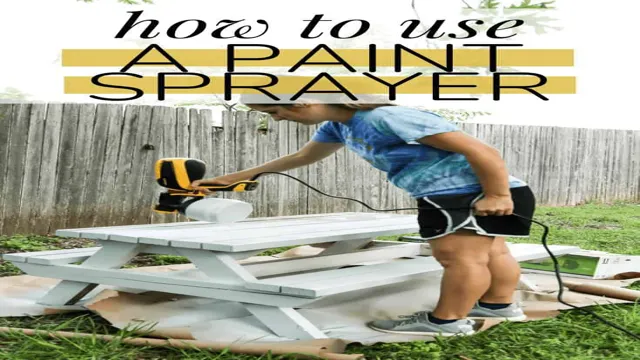
Cover surfaces not to be painted
When it comes to painting, preparing the area is just as important as the actual painting process. One crucial step in preparing the area is covering any surfaces that you don’t want to be painted. This can include floors, furniture, fixtures, and trim.
Not only does it protect these surfaces from accidental splatters or drips, but it also makes clean-up much easier. The last thing you want is to finish painting only to realize that you’ve also painted your new hardwood floors! One great way to cover surfaces is by using drop cloths or plastic sheeting, which can be easily taped down and removed once you’re finished with the painting. Remember, taking the extra time to properly prepare the area before starting will lead to a more successful and stress-free painting experience.
Selecting and Preparing the Paint
When using a paint sprayer, one critical factor to consider is selecting and preparing the paint. First, ensure that the paint is suitable for your sprayer. Using the wrong type may clog or damage your equipment.
Typically, thinning the paint to the manufacturer’s recommended consistency allows for the smooth application and reduces the need for frequent refills. Most paint sprayers come with a viscosity cup that allows you to check the thickness of your paint before application. To prepare the paint for spraying and avoid any impurities, strain it through a sieve or filter first.
Finally, ensure you have enough paint for the entire project to avoid encountering any issues in the middle of painting. With these steps, your paint sprayer is ready to deliver a smooth and even finish on your project.
Choose the right paint for the job
When it comes to selecting and preparing paint for a job, it’s important to consider the type of surface you’ll be painting and the purpose of the paint. Different surfaces require different types of paint, so it’s important to choose the right one for the job. For example, oil-based paint is great for surfaces that are prone to wear and tear, while water-based paint is perfect for surfaces that are exposed to moisture.
Additionally, you should consider the purpose of the paint, whether it’s for interior or exterior use, and if it’s meant for a specific room or space. Before applying any paint, make sure the surface is properly prepared by cleaning it and sanding down any rough areas. Proper preparation will ensure that the paint adheres properly and provides long-lasting results.
Overall, selecting the right paint for the job and properly preparing the surface will ensure a successful painting project.
Thin the paint, if necessary
When selecting paint for a project, it’s important to choose the right consistency. Some paints might be too thick, while others might be too thin. If your paint is too thick and hard to brush or roll onto your surface, it’s time to thin it out! You can thin your paint by adding a little bit of water or paint thinner to the mix.
Be sure to add it in slowly, however, because you don’t want to make it too runny. Start with a small amount and gradually increase until you reach the preferred consistency. Always read the manufacturer’s instructions before adding any thinning agents to your paint.
By carefully selecting and preparing your paint, you’ll have a much easier time achieving the desired finish on your project.
Loading the Sprayer
Using a paint sprayer can seem intimidating, but once you get the hang of it, it can save you time and effort. The first step in using a paint sprayer is loading it with paint. Before doing so, make sure to read the manufacturer’s instructions carefully.
Generally, you will need to dilute your paint with water or paint thinner to ensure that it flows smoothly through the sprayer. Once you have done so, pour your paint into the sprayer’s container, making sure not to overfill it. Secure the container onto the sprayer and plug it in.
Before spraying, test the sprayer on a piece of cardboard or scrap wood to ensure that the paint is flowing evenly and to the desired thickness. And there you have it – with these steps, you’re well on your way to using a paint sprayer like a pro.
Fill the cup or container
When loading your sprayer, it’s important to ensure that you fill the cup or container correctly. The process may seem straightforward, but it’s crucial to get it right to guarantee the best results. Firstly, make sure that the container is clean and dry before you begin.
Using a dirty container can contaminate the solution you’re trying to spray, potentially causing damage to your plants or, worse still, compromising your safety. Secondly, fill the container to the recommended level indicated on your sprayer’s instructions. Overfilling can lead to spillages and wastage, whilst under-filling can affect the accuracy of your spray pattern.
Finally, it’s critical to add the correct amount of solution to the container, measured out as specified by the label of your chemicals. Too much or too little solution can be dangerous and could lead to negative consequences. Following these simple steps will ensure that you get the most out of your sprayer and keep you and your plants safe from harm.
Attach the sprayer to a power source
When it comes to loading a sprayer, one of the first steps is to attach it to a power source. This can be done in a few different ways depending on the type of sprayer you have. For electric sprayers, you’ll want to make sure that the battery is fully charged before starting.
If it’s not, plug it into an outlet and let it charge for a few hours. Once it’s fully charged, attach it to the sprayer by connecting the wires to the proper terminals. For gas-powered sprayers, you’ll need to fill up the tank with fuel before starting.
Make sure you’re using the correct type of fuel recommended by the manufacturer. Once the tank is filled, attach the power source to the spark plug and pull the cord to start the engine. With either type of sprayer, it’s important to follow the manufacturer’s instructions carefully to ensure that you’re attaching the power source correctly and safely.
By taking the time to load your sprayer properly, you’ll be more efficient and effective in your spraying tasks.
Adjusting the Sprayer Settings
When using a paint sprayer, it’s important to adjust the settings to get the best results. The first thing to consider is the type of paint and the thickness of the coating you’re using. This will inform the size of the tip you need on your sprayer, as well as the pressure setting.
You’ll need to experiment to find the right combination of tip and pressure, and it’s a good idea to practice on a scrap piece of material before you start painting. Once you’re happy with your settings, you can start spraying, keeping the nozzle at a constant distance from the surface and moving it in a smooth, even stroke. If you find that the paint is coming out in blobs or droplets, you may need to adjust your settings, or thin your paint to make it easier to spray.
With a little practice, you’ll soon get the hang of using a paint sprayer and achieve a professional finish on all your projects.
Adjust spray pattern and flow
When it comes to using a sprayer for your garden or yard, the right spray pattern and flow can make all the difference. Adjusting these settings can ensure that your plants are getting the right amount of coverage and that you are using your sprayer efficiently. To adjust the spray pattern, look for a dial on the sprayer that allows you to choose between a wide fan, narrow stream, or somewhere in between.
This will determine how wide the spray will be and how concentrated it is. To adjust the flow, which determines how much liquid comes out, look for a control knob or lever that can be turned up or down. It’s important to find a balance between the flow and the pattern for the best results.
With these settings adjusted to perfection, your sprayer will be a powerful tool for maintaining a healthy and beautiful garden.
Test settings on scrap material
When it comes to painting, adjusting your sprayer settings properly makes all the difference. But before you start spraying away on your project, it’s important to first test your settings on scrap material. This will allow you to fine-tune your sprayer to ensure you achieve the desired results on your actual project.
Begin by selecting a piece of scrap material that is similar to the material you’ll be painting. Then, adjust your sprayer’s pressure, nozzle size, and spray pattern until you obtain the desired coverage and finish. Remember, small adjustments can make a big impact, so take your time and don’t rush the process.
By testing your settings on scrap material, you’ll save time and materials in the long run and achieve a professional-looking finish that you can be proud of. So, take the time to adjust your sprayer settings properly, and watch your project come to life.
Spraying the Paint
One of the most efficient ways of painting a surface is by using a paint sprayer. But how do you use a paint sprayer? First, it is essential to prepare the surface by ensuring that it is free of any dust, dirt, or debris. Then, mix the paint according to the manufacturer’s instructions.
Before starting to spray, test the sprayer on a scrap piece of paper or wood to adjust the pressure and get the desired spray pattern. Once you are comfortable with the sprayer’s spray pattern, paint the surface by holding the sprayer about six to eight inches away from the surface. Ensure that you move the sprayer in a sweeping motion for even coverage.
While spraying, it’s crucial to keep the sprayer perpendicular to the surface for maximum coverage and to avoid runs. Lastly, let the paint dry completely before applying the second coat, if needed. Using a paint sprayer saves time and ensures a smooth and even coat of paint.
Move the sprayer in a consistent motion
When it comes to painting, achieving a smooth, even coat can be a challenge. One of the most critical steps in the process is spraying the paint in a consistent motion. This means moving the sprayer at a steady pace from side to side or up and down, with each pass overlapping the previous one slightly.
If you move too quickly, the paint may appear patchy and uneven, while moving too slowly can result in drips and sags. It takes practice to find the right speed and stroke, but with a little patience, your results can be impressive. Remember, a smooth and even coat of paint will add a professional touch to your project, whether you’re painting a room, furniture, or a piece of art.
So take your time, and keep that sprayer moving in a consistent motion!
Overlap each pass by 50%
When it comes to painting, whether for a DIY project or a professional job, spraying the paint is a popular method of application. To ensure a smooth and even coat, it’s important to overlap each pass by 50%. This means that each time you spray, the next pass should cover half of the previous one.
This technique helps to prevent inconsistencies in the paint coverage and creates a uniform finish. It’s also essential to maintain a consistent distance from the surface being painted to avoid creating areas that are too thick or too thin. By following these simple steps, you can achieve a professional-looking paint job with a spray application.
So don’t be afraid to give spraying a try for your next project!
Cleaning the Paint Sprayer
If you’re wondering how to use a paint sprayer, one of the most important steps in the process is cleaning. After you’ve finished spraying, it’s essential to ensure that the sprayer is thoroughly cleaned to prevent any clogs or damage to the equipment. Start by unplugging the machine and releasing any remaining paint into a container.
Then, disassemble the nozzle and other removable parts and wash them in warm soapy water. Use a brush to remove any built-up paint or residue and rinse everything thoroughly. Once everything is properly cleaned and dry, reassemble the sprayer and store it in a safe place until your next use.
By taking the time to clean your paint sprayer after each use, you can ensure that it will continue to work effectively for years to come.
Flush the sprayer with water or cleaning solution
One of the most important steps in maintaining your paint sprayer is cleaning it thoroughly after every use. This will not only extend the life of your equipment, but will also ensure a consistent and high-quality finish on your paint job. To clean your sprayer, start by flushing it with water or a cleaning solution recommended by the manufacturer.
This will remove any excess paint and debris that may be left in the sprayer, preventing clogs and other issues down the line. It’s important to follow the manufacturer’s guidelines on what type of cleaning solution to use, as using the wrong type can damage the sprayer’s internal components. Once you’ve flushed the sprayer, make sure to disassemble it fully and clean every part thoroughly before reassembling.
As a general rule, it’s also a good idea to clean your sprayer at the end of each day or after every use to avoid buildup of dried paint or debris. By following these steps, you’ll ensure your paint sprayer stays in top condition for years to come.
Disassemble and clean all parts thoroughly
When it comes to cleaning the paint sprayer, it’s important to disassemble all of the parts before getting started. This will allow you to clean every nook and cranny thoroughly and prevent any clogs or build-up from forming in the future. Make sure to check your owner’s manual for specific instructions on how to properly disassemble the sprayer.
Once the parts are removed, you can begin cleaning each piece in warm soapy water. To get rid of tough stains or dried paint, consider using a brush or scraper to gently scrub away any remaining residue. After cleaning, be sure to dry all parts completely before reassembling the sprayer.
Remember, a clean sprayer not only ensures proper functioning but also helps to improve the quality of your paint job. So take the time to disassemble and clean all parts thoroughly, and you’ll be one step closer to a flawless finish. Let’s keep our paint sprayer in top-notch condition!
Conclusion
Using a paint sprayer is like creating your own personal art exhibit – except the canvas is your walls and furniture! With precision and skill, you can transform any space into a masterpiece in no time. Just remember to choose the right paint and adjust the settings on your sprayer for optimal coverage. So go ahead, unleash your inner Picasso and paint the town (or your house) your way!”
FAQs
What types of paint sprayers are available?
There are three main types of paint sprayers: airless, HVLP, and compressed air.
Do I need to thin my paint before using a paint sprayer?
It depends on the type of paint sprayer and the paint you are using. Airless and HVLP sprayers generally do not require thinning, while compressed air sprayers may require some thinning.
How do I clean my paint sprayer after use?
You should follow the manufacturer’s instructions for cleaning your specific paint sprayer. Typically, you will need to flush out any remaining paint with an appropriate solvent, then disassemble and clean the sprayer components thoroughly.
Can I use a paint sprayer indoors?
Yes, you can use a paint sprayer indoors, but it is important to take proper safety precautions like wearing a respirator and covering surrounding surfaces and objects to prevent overspray.
How do I adjust the spray pattern on my paint sprayer?
The method for adjusting the spray pattern will vary depending on the type of sprayer you have. Generally, there will be a knob or lever to adjust the pattern size and shape.
How do I prevent clogs while using a paint sprayer?
Using the correct viscosity of paint, straining paint before use, and avoiding painting in extremely high or low temperatures can help prevent clogs in your paint sprayer.
Can I use my paint sprayer for multiple types of projects?
Yes, paint sprayers are versatile tools and can be used for a variety of projects, including furniture refinishing, exterior painting, and more. Just be sure to use the appropriate tip and pressure settings for each project.

